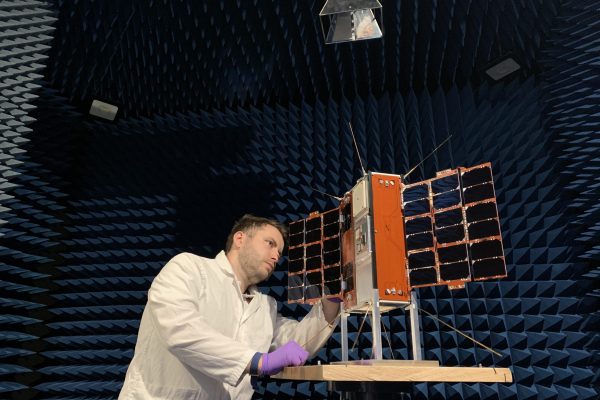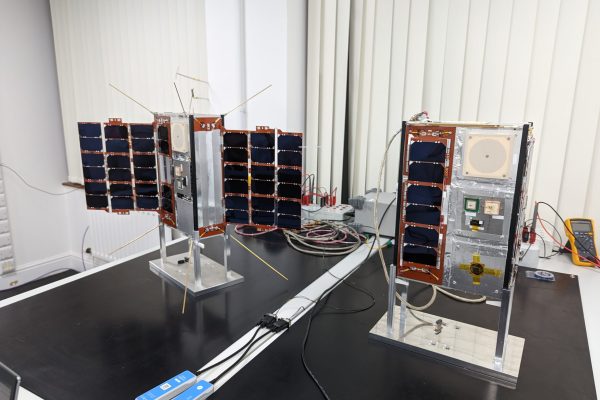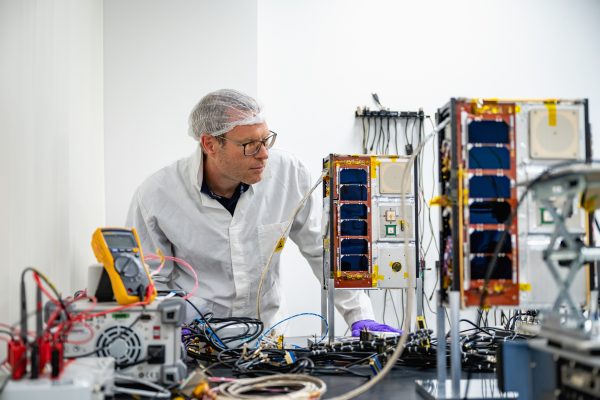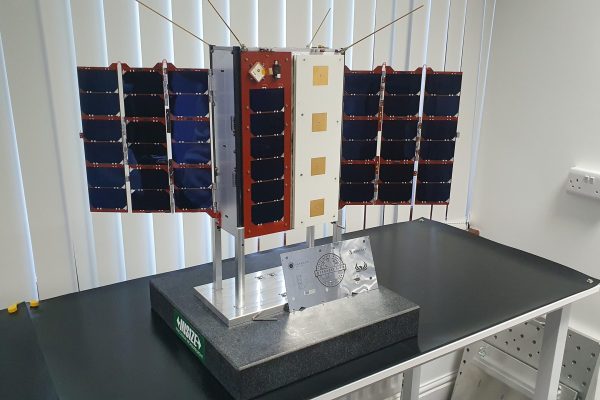Customer: BAE Systems
Spacecraft: Faraday Bell
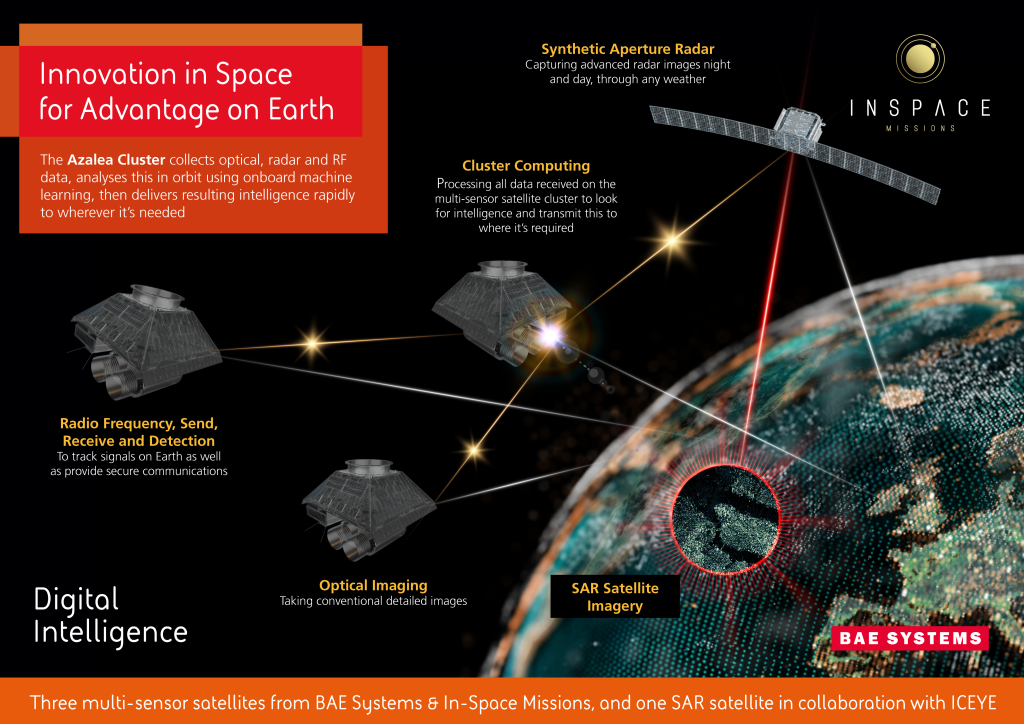
In-Space Missions is working with BAE Systems to provide the capability to design, build, launch and operate their Azalea* satellites. Azalea is a multi-sensor satellite cluster that will be launched into low Earth orbit in 2024 to deliver high-quality information and intelligence in real time from space to military customers.
Azalea will use a range of sensors to collect visual, radar and radio frequency (RF) data, which will be analysed by on board machine learning on edge processors to deliver the resulting intelligence securely, anywhere in the world while still in orbit.
The Azalea cluster will deliver timely, actionable intelligence, essential for military operations and disaster response. Comprising four highly resilient satellites which, together, are capable of gathering, analysing and communicating Synthetic Aperture Radar (SAR), optical and RF signals.
Unlike conventional, single-purpose satellites, the cluster can be fully reconfigured whilst in orbit in the same way a smartphone installs a new app; this ensures it can deliver future customer missions and expands the lifecycle of the satellites.
BAE Systems is working with Finnish firm, ICEYE, to combine its own expertise in sensor technology with ICEYE’s advanced SAR technology to be included in the cluster.
Existing space-based sensors require multiple terabytes of data to be transferred to Earth before being processed and distributed. The traditional transfer process can take many hours and is reliant on intermittent RF links and the availability of suitable ground stations. The Azalea system saves valuable time by combining and analysing data in space. It will be able to identify activities of interest and directly communicate with users on the ground within moments of detection – securely delivering assured data, in a useful timeframe, directly to the hands of decision makers.
*Azalea is trademarked
Faraday Dragon Rideshare Service
Spacecraft: Faraday Bell
60kg payload mass
 We are working to finalise partners and payloads for Faraday Dragon, an Asia-Pacific regional satellite rideshare mission, in 2026. Faraday Dragon is a 150kg class satellite platform with a 5 year mission lifetime that will fly multiple payloads for regional space players including government, commercial, financial, research and educational organisations and we offer our customers a full end-to-end ultra low-cost rideshare service.
We are working to finalise partners and payloads for Faraday Dragon, an Asia-Pacific regional satellite rideshare mission, in 2026. Faraday Dragon is a 150kg class satellite platform with a 5 year mission lifetime that will fly multiple payloads for regional space players including government, commercial, financial, research and educational organisations and we offer our customers a full end-to-end ultra low-cost rideshare service.
- Demo and service delivery up to 5 years lifetime
- Formation flying
- Intersatellite links
- LEO to GEO links
We currently have some payload space available – get in touch to find out more.
Titania
Technology demonstration mission for optical communications
Customer – Dstl
Spacecraft: Faraday-Bell platform, 25kg payload mass
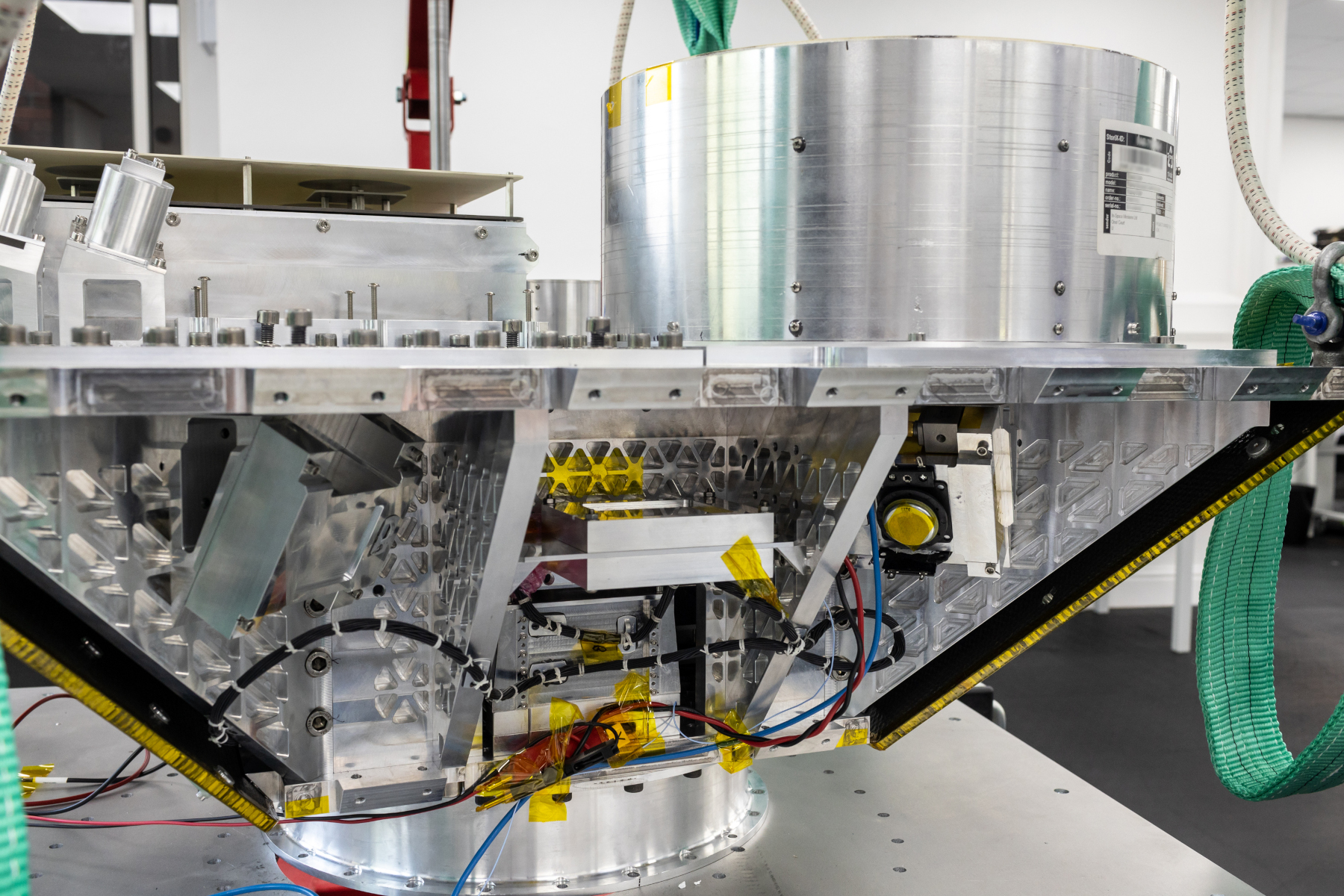 The Titania Mission will demonstrate 10 gigabits per second optical communications from orbit, which in the right conditions is up to 139 times faster than the average UK home broadband. The Titania spacecraft, launching in 2023, will feature multiple payloads demonstrating and characterising high-speed free space optical uplinks and downlinks for UK Defence and Security applications. The space segment of the Titania mission will utilise the novel In-Space Missions ‘Faraday-Bell’ satellite bus and Software Defined Radio payload.
The Titania Mission will demonstrate 10 gigabits per second optical communications from orbit, which in the right conditions is up to 139 times faster than the average UK home broadband. The Titania spacecraft, launching in 2023, will feature multiple payloads demonstrating and characterising high-speed free space optical uplinks and downlinks for UK Defence and Security applications. The space segment of the Titania mission will utilise the novel In-Space Missions ‘Faraday-Bell’ satellite bus and Software Defined Radio payload.
The Titania space mission will accelerate the development and adoption of space-based optical communications, allowing our Armed Forces the ability to operate in an increasingly contested environment. The Titania satellite will be used to support the UK space sector and provide a solid foundation on which to conduct experimentation into FSOC and allow the science to be developed.
Prometheus-2 Cubesats
Launch failure January 2023
Customer – Dstl for UK Ministry of Defence
Spacecraft: 6U cubesat
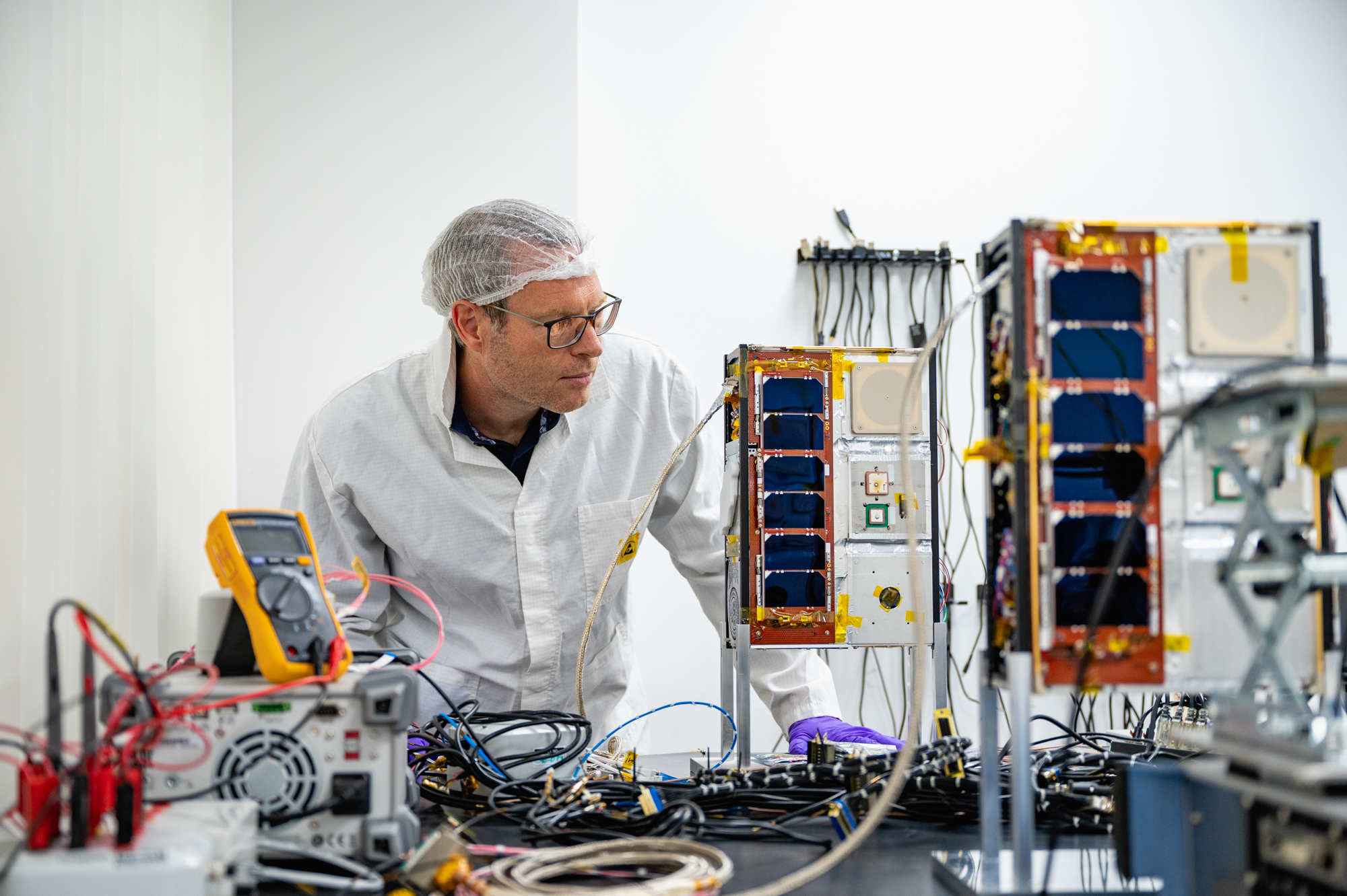 The two Prometheus 2 cubesats were jointly designed by In-Space Missions and Airbus and Defence and Space, and constructed at In-Space Missions.
The two Prometheus 2 cubesats were jointly designed by In-Space Missions and Airbus and Defence and Space, and constructed at In-Space Missions.
The launch from Newquay Airport on Cosmic Girl, a modified 747 aircraft, was the UK’s first ever orbital launch and was set to carry nine spacecraft into low Earth orbit (LEO). Launch failure occurred at some point during the firing of the rocket’s second stage engine and the mission did not achieve final orbit.
The Prometheus-2 cubesats were each the size of a cereal box and owned by Dstl on behalf of the Ministry of Defence, and co-funded by Airbus Defence and Space who designed them jointly with In-Space Missions.
The Prometheus-2 cubesats had a mass of 8.5kg and measured just 30cm X 20cm X 10cm. They were built by In-Space Missions to provide a test platform for sophisticated Earth imaging and radio signal monitoring (including GPS), paving the way for a more collaborative and connected space communication system with the UK’s combat allies. The cubesats each had separate equipment installed to test future concepts in support of the MOD’s ISTARI programme for future space-based intelligence and surveillance.
Cubesat 1 carried a hyperspectral imager and GPS receiver and Cubesat 2 carried two optical imaging cameras and a GPS receiver. Common to both spacecraft were remotely programmable payloads, through which all satellite instruments could be commanded, and utilising modern Software Defined Radio technology, the payloads would enable third party organisations to use the Prometheus 2 constellation to research or demonstrate techniques such as:
- Geolocation (of radiating entities)
- Space Domain Awareness
- In-orbit data processing (including AI)
- Interference monitoring
- Signal Gathering
- Alternate Navigation
- Inter-Satellite Communications
Faraday Phoenix
Rideshare service – Launched July 2021
Spacecraft: Faraday Generation 1 6U
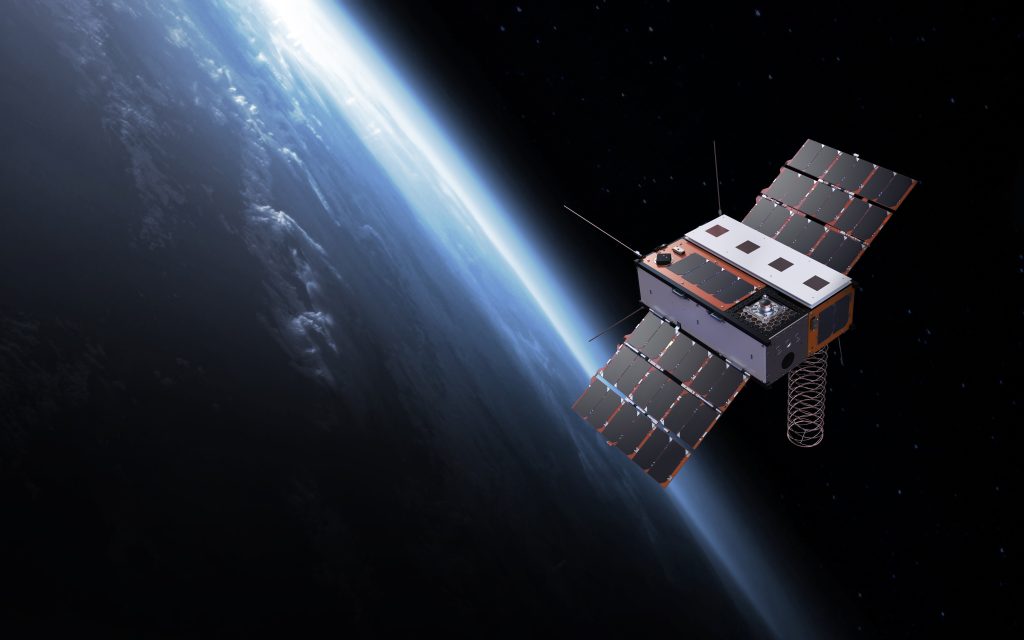 Faraday Phoenix was developed in less than 8 months and was the world’s first commercial rideshare satellite mission when it launched in July 2021 on Spaceflight’s SXRS5 Transporter 2 mission from Cape Canaveral, USA. The spacecraft carries payloads for 6 customers including Airbus, Lacuna, SatixFy and Aeternum as well In-Space’s own Babel payload. The Babel payload is In-Space’s first incarnation of a future digital, uploadable payload offering within the Faraday service. This first generation is a high gain, wideband software defined radio with over 500 MHz of available bandwidth which enables a number of different applications to be uploaded and exercised – from tracking ship radars to creating heat maps of 4G mobile usage.
Faraday Phoenix was developed in less than 8 months and was the world’s first commercial rideshare satellite mission when it launched in July 2021 on Spaceflight’s SXRS5 Transporter 2 mission from Cape Canaveral, USA. The spacecraft carries payloads for 6 customers including Airbus, Lacuna, SatixFy and Aeternum as well In-Space’s own Babel payload. The Babel payload is In-Space’s first incarnation of a future digital, uploadable payload offering within the Faraday service. This first generation is a high gain, wideband software defined radio with over 500 MHz of available bandwidth which enables a number of different applications to be uploaded and exercised – from tracking ship radars to creating heat maps of 4G mobile usage.
The next generation of the Babel payload will boast a bandwidth covering from 200 MHz up to 30GHz, offering unprecedented digital access to space and will fly in Q3 2023 and Q2 2024.
Faraday-1
Rideshare service – Launch failure July 2020
Spacecraft: Faraday Generation 1 6U
In-Space’s Faraday-1 nanosat was launched on a Rocket Lab Electron rocket in July 2020 from New Zealand, but the launch vehicle failed in its late ascent, losing Faraday-and several other satellites launching with Electron. Faraday-1 had been carrying payloads from several customers including Airbus Defence and Space, Kleos Space, Lacuna Space, the Space Environment Research Centre in Canberra, Canadensys Aerospace and Aeternum.
